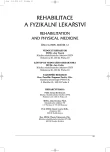Painful Dysfunction Syndromes of the Shoulder: The Role of Short Depressors of the Humeral Head
Authors:
M. Mayer 1,2; D. Smékal 1
Authors‘ workplace:
Katedra fyzioterapie, Fakulta tělesné kultury UP, Olomouc
vedoucí prof. MUDr. J. Opavský, CSc.
1; Klinika rehabilitačního a tělovýchovného lékařství LF UP a FN, Olomouc
přednosta doc. MUDr. Č. Číhalík, CSc.
2
Published in:
Rehabil. fyz. Lék., 12, 2005, No. 2, pp. 68-71.
Category:
Original Papers
Overview
Motor control of the shoulder girdle, joint centration and stability resulting in skillfull hand movements are ontogenetically recent, hence easily disturbed functions. Dysfunction of the shoulder joint frequently causes structural changes and vice versa. A primary structural lesion causes disturbed neuromuscular movement patterns at the shoulder. There are two main factors which stabilise the shoulder joint: active positioning of the shoulderblade, and the muscles of the rotator cuff which depress and thus centrate the joint, the key muscle being the subscapularis. For physiotherapy to be effective, we have to respect these principles when applying kinesiotherapy.
Key words:
the shoulder, glenohumeral centration, humeral head depressors, impingement
Labels
Physiotherapist, university degree Rehabilitation Sports medicineArticle was published in
Rehabilitation & Physical Medicine

2005 Issue 2
Most read in this issue
- Painful Dysfunction Syndromes of the Shoulder: The Role of Short Depressors of the Humeral Head
- Standing up from the Sitting Position in Clinical Practice
- McKenzie Mechanical Diagnosis of Functional Syndromes of the Musculoskeletal System
- Dynamics of Functional Muscle Changes in Young Tennis Players
